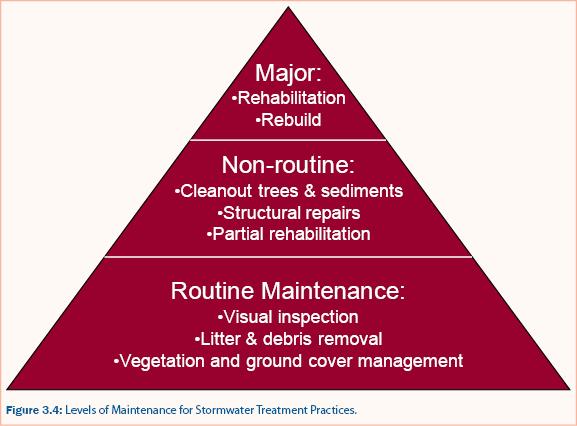
Levels of Maintenance
A.J. Erickson, P.T. Weiss, J.S. Gulliver, R.M. Hozalski, B.C. Asleson
Stormwater treatment practice maintenance is the purposeful management of a practice so as to maintain a desired level of performance and efficiency and consists of short-term (routine or more frequent), long-term (non-routine or less frequent), and major (rare) actions (Figure 3.4).

Performance longevity of stormwater treatment practices from their creation (design and construction) through operative stages (functional or not) is dependent on maintenance actions. Because maintenance involves a significant amount of resources (personnel, equipment, materials, sediment disposal expense, etc.), the more that is learned about stormwater treatment practice performance, the easier it will be to schedule appropriate and cost-effective maintenance to maintain optimal performance and extend the useable life of the practice. Therefore, assessment using a combination of the four levels to determine performance of a stormwater treatment practice is a necessary step in developing a cost-effective maintenance program.
The results from an assessment program are used to adaptively develop a maintenance program for stormwater treatment practices. For example, visual inspection (level 1) of a bioretention practice (rain garden) could indicate that a significant amount of sediment has accumulated near the inlet of the practice. Capacity testing (level 2) could indicate that approximately 20 cubic feet of sediment has accumulated (sediment retention) and that the hydraulic conductivity in the area of sediment accumulation is minimal compared to design. Therefore, maintenance should be scheduled to remove the accumulated sediment and restore the water and sediment storage capacity as well as the infiltration capacity in the area near the inlet of the practice. Conducting visual inspection and capacity testing regularly could determine that sediment removal maintenance is required every 2-3 years for this practice. Conducting maintenance on this schedule could prevent costly rehabilitation or rebuilding of the entire practice and extend the useable life of the practice by maintaining infiltration throughout the entire practice. Recommendations for scheduling maintenance and common maintenance frequency, effort, and cost are provided in each of the Filtration, Infiltration, Sedimentation, and Biologically Enhanced Practices sections of this manual.
A general rule-of-thumb is that cumulative maintenance costs equal design and construction costs (excluding land costs) after ten years for a stormwater treatment practice with a $10,000 (2005) design and construction cost, and will equal design and construction costs after 20 years for a stormwater treatment practice with a $100,000 design and construction cost (excluding land costs). Thus, there is an economy of scale for the maintenance of stormwater treatment practices because the maintenance cost, relative to construction costs, will cost less for a larger stormwater treatment practice. The available information on maintenance costs will be reviewed in each of the Filtration, Infiltration, Sedimentation, and Biologically Enhanced Practices sections of this manual.
Continue to Water Budget Measurement.